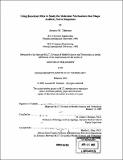| dc.contributor.advisor | M. Charles Liberman. | en_US |
| dc.contributor.author | Taberner, Annette M., 1973- | en_US |
| dc.contributor.other | Harvard University--MIT Division of Health Sciences and Technology. | en_US |
| dc.date.accessioned | 2008-02-28T16:08:57Z | |
| dc.date.available | 2008-02-28T16:08:57Z | |
| dc.date.copyright | 2005 | en_US |
| dc.date.issued | 2005 | en_US |
| dc.identifier.uri | http://dspace.mit.edu/handle/1721.1/30273 | en_US |
| dc.identifier.uri | http://hdl.handle.net/1721.1/30273 | |
| dc.description | Thesis (Ph. D.)--Harvard University--MIT Division of Health Sciences and Technology, 2005. | en_US |
| dc.description | Includes bibliographical references (leaves 91-97). | en_US |
| dc.description.abstract | The ease of targeted genetic modification makes the mouse a valuable model to study hearing and deafness. A powerful window into cochlear function can be obtained by recording from single auditory (AN) fibers, primary afferents connecting cochlear inner hair cells to the brain. This thesis provides the first systematic analysis of fundamental response properties of the mouse AN, including rate and timing of spontaneous and sound-evoked discharge, frequency selectivity, dynamic range, and the relations between spontaneous rate and these other response properties. Three wildtype strains were compared: CBA/CaJ (because it retains normal cochlear sensitivity as it ages); and C57BL/6 and 129/SvJ (because they are used in "knockout" generation). Two lines with targeted deletion of inner ear genes were also studied. The cochlea in mouse responds to frequencies octaves higher than in humans or most other mammals; nevertheless, most other AN characteristics were fundamentally similar to those in well-studied mammals. The only significant differences were 1) smaller dynamic ranges in all three strains; and 2) high-frequency threshold elevation and tuning degradation in C57BL/6 and 129/SvJ, consistent with early-onset degeneration of basal-turn sensory cells in these strains. The mutant lines studied included deletion of 1) Calcitonin-Gene-Related Peptide (CGRP), a neurotransmitter expressed by cochlear efferent fibers, or 2) the a subunit of BK channels, a large-conductance K+ channel, expressed in hair cells and AN fibers, and implicated in cochlear tuning in lower vertebrates. | en_US |
| dc.description.abstract | (cont.) Loss of CGRP had no detectable effect on AN responses, suggesting a minimal role in cochlear processing. Loss of BK channels led to dramatic decreases in sound- evoked discharge rates and spike synchronization, without changes in frequency selectivity. The degraded spike synchronization likely arises from slowing rise-times of inner hair cell receptor potentials observed in vitro; the decreased steady-state rates likely arise from depolarization block in the AN fibers themselves. | en_US |
| dc.description.statementofresponsibility | by Annette M. Taberner. | en_US |
| dc.format.extent | 97 leaves | en_US |
| dc.language.iso | eng | en_US |
| dc.publisher | Massachusetts Institute of Technology | en_US |
| dc.rights | M.I.T. theses are protected by copyright. They may be viewed from this source for any purpose, but reproduction or distribution in any format is prohibited without written permission. See provided URL for inquiries about permission. | en_US |
| dc.rights.uri | http://dspace.mit.edu/handle/1721.1/30273 | en_US |
| dc.rights.uri | http://dspace.mit.edu/handle/1721.1/7582 | |
| dc.subject | Harvard University--MIT Division of Health Sciences and Technology. | en_US |
| dc.title | Using knockout mice to study the molecular mechanisms that shape auditory nerve responses | en_US |
| dc.type | Thesis | en_US |
| dc.description.degree | Ph.D. | en_US |
| dc.contributor.department | Harvard University--MIT Division of Health Sciences and Technology | |
| dc.identifier.oclc | 60847579 | en_US |
